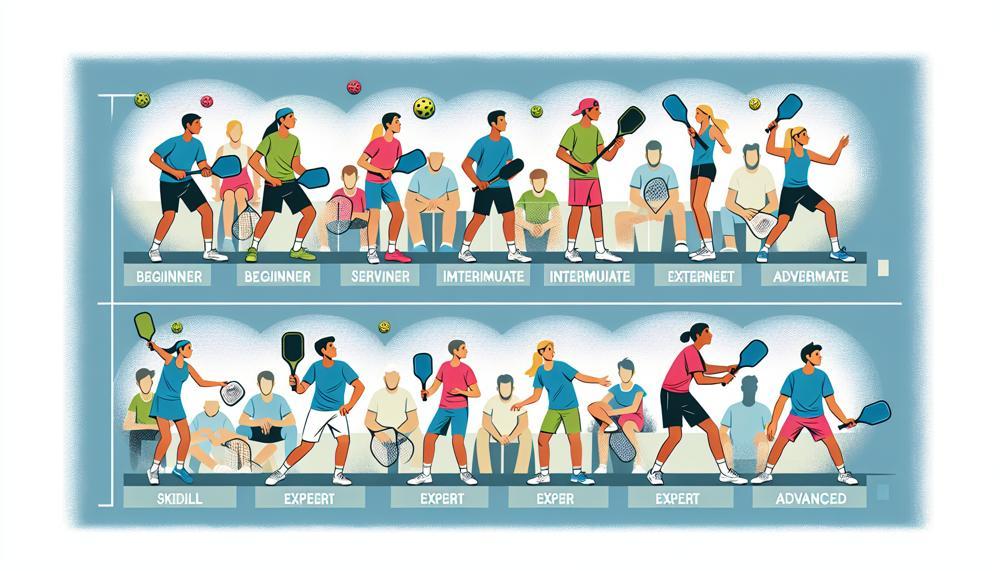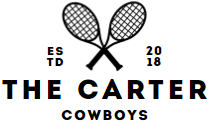Have you recently discovered pickleball and are eager to find out what your skill level is?
Or perhaps you’re a veteran player trying to accurately assess your court skills. No matter where you fall on the spectrum, knowing your pickleball skill level is crucial to improving and enjoying the game.
Each skill level has its own unique set of tactics and strategies, from novice to expert. We’ll explore the various levels of pickleball in this blog post, as well as some valuable tips on how to determine where you stand.
So, grab your paddle and get ready to discover your true pickleball prowess.
Table of Contents
What Are Pickleball Ratings?
Pickleball has soared in popularity, prompting the need for a standardised system for assessing players’ skill levels. Pickleball ratings enter play here.
What Do Pickleball Ratings Evaluate?
Pickleball ratings are used to measure a player’s skill in the game. They take into account a variety of aspects, including shot execution and strategic analysis.
Specific skills such as forehand, backhand, serve, dink, third shot, andvolley are all monitored. The more advanced the player’s abilities are considered to be, the higher the score.
How do I know my pickleball skill level?
A player’s skill in pickleball is determined by their physical and mental abilities.
Forehands, serves, dinks, volleys, hand-eye coordination, and agility are all essential for tennis.
Strategic abilities include:
- Adaptive play styles
- Pace control
- Tactical placement
Rated pickleball players normally get a two- or four-digit number. Here are some rating systems:
- DUPR: Ranges from 2.000 to 8.000 and adapts to a player’s skill level over time
- WPR: Lists 2-digit and 4-digit ratings for doubles, mixed, and singles
Here are some skill levels:
- 1.0 to 2.0: Players are just starting to play pickleball and know the basics of how it works.
- 2.5: Players don’t have much experience, but they can usually get their serves and returns right.
- 3.0 below: At first
- 3.5–4.0: Middle Level
- 4.5 to 5.0+: Advanced
Why Are Pickleball Ratings Important?
Pickleball’s game is often underestimated, with new players often forgetting the importance of ratings. However, these figures have a lot more to do with the game than simply being random numbers.
Pickleball Ratings’ Pharical Magic reveals itself.
Fair Competition
Fair play is king in the sport of athletics. For a challenging and enjoyable experience, players of similar skill levels will face each other in a similar manner. Pickleball ratings come into play, combining players with similar abilities to ensure a fair playing field for all.
Progress Tracking

Pickleball ratings can also be used to gauge an individual’s progress and growth in the sport. As players improve their skills on a regular basis, their ranking will change, reflecting their growth. This can be a good motivator to push oneself further and achieve higher skill levels.
Tournament Eligibility
In tournament eligibility, the explosion of pickleball ratings is also evident. For several tournaments, players must be rated or skill level in order to participate.
This ensures that only players of a certain skill level compete against each other, thus making the tournament fair and giving players an opportunity to challenge themselves and improve.
Determining Pickleball Ratings: The Mysteries of Determination Pickleball Ratings.
Self-Rating
Some athletes may choose to self-rate themselves based on their own assessment of their abilities.
However, this could lead to inaccuracies and a lack of ratings. For a more precise analysis, players must be honest with themselves when self-rating and continue to strive for improvement.
Official Rating Systems
There are official rating schemes in place for a more complete and objective analysis, such as the USAPA (USA Pickleball Association) rating system. To determine a player’s rating, these programs use a combination of skill-level assessments and tournament results.
These tools, which have been developed and refined over time, provide a realistic and comprehensive assessment of a player’s abilities.
How Is My Rating Calculated?
Pickleball, a rare blend of tennis, badminton, and ping-pong, has seen a surge in success in recent years. It’s also a skill set to classify players and ensure fair play. But have you ever wondered how these pickleball skill levels are figured out? We’ll explore the mystery behind pickleball ratings and their significance in this blog post.
Pickleball has six skill levels: 2.5, 3.0, 3.5, 4.5, 4.5, 4.5, and 5.0, with 2.5 being the beginner level and 5.0 being the professional level. The USA Pickleball Association (USAPA), the national governing body of pickleball in the United States, has developed a rating system on which these rankings are based.
Although some may see this as a limited number in comparison to other racket sports, it is important to note that pickleball is a relatively new sport, and as its success rises, new skill levels may be added in the future.
However, how can the USAPA determine these skill levels? The association has developed an extensive roadmap for each level that outlines the skills and abilities required to achieve that rank.
These guidelines take into account various aspects of the game, such as serving, volleying, dinking, and court coverage. This ensures fair placement of players at appropriate skill levels and encourages them to compete against others with similar abilities.
The use of the “dinking” technique makes a major difference between pickleball’s skill levels and those of other racket sports. As mentioned earlier, dinking is a delicate shot played close to the net, and it is a vital component of pickleball’s tactics. This technique is not widely used in other racket sports, and it requires a different degree of skill and patience to execute it properly.
In addition, the smaller court size in pickleball (one-third the size of a tennis court) requires players to have quick reflexes and efficient court coverage, resulting in a unique set of competencies in comparison to larger courts.
In addition, the USAPA rating system treats both on-court results and self-rating. Certified referees assess on-court results during tournaments or league play, while self-rating allows players to assess their own abilities and determine their starting level.
Classifying Your Skill Level
Pickleball, the fast-paced mashup of tennis, badminton, and ping-pong, has taken over the world. Its allure lies in its ability to captivate players of all ages and skill levels, making it a thrilling and rewarding experience for those who partake.
Have you ever considered the mysterious process of determining your pickleball skills? We’ll explore the criteria used to rank players and the USA Pickleball Association’s common rating system (USAPA).
Criteria for Unraveling Skill Levels
The USAPA has established a set of perplexing criteria to unravel a player’s skill level in pickleball. These inscrutable factors include:
- Knowledge: An individual must have taken beginners’ lessons or possess equivalent knowledge about the game. This entails understanding scorekeeping, rules, and proper court positioning during serves, receipts, and general play.
- Movement: A player must exhibit balanced and safe movement around the court.
- Serving: Although it is not imperative to consistently make serves, a player should be able to achieve some successful attempts.
- Stroke Skills: Basic stroke skills such as forehand, backhand, volley, and overhead shots are essential for a player to possess.
When deciphering skill level, the USAPA takes into account enigmatic elements such as court coverage and firing execution.
The Mysteries of the Pickleball Rating System
The USAPA has developed a standardized pickleball rating system to ensure fair competition among players. Each player is assigned a 5-digit or 9-digit number based on their talent level. The more skilled the player is considered to be, the higher the number.
This device is based on the arcane ELO rating system, which is also used in chess and other sports. The evaluation is based on an individual’s match results and assigns a score accordingly.
For example, if a player with a rating of 3.5 (internal level) triumphs over a player with a rating of 3.0 (beginner level), the winning player’s rating will rise to 3.6, while the losing player’s rating will fall to 2.9.
This helps ensure that a player’s skill level remains fluid and accurately reflects their present abilities on the court.
Pickleball Skill Rating
Pickleball has soared in esteem, with people of all ages and abilities flocking to the courts. The question of one’s pickleball skill rating has become a hot topic as interest grows. We will explore the various types of ratings and their methods of evaluation in this article.
Self-rating: The Good, The Bad, The Ugly
The most common method of pickleball skill rating is self-rating, which is often used in recreational play. Players are given a rating ranging from 1.0 to 6.0, with higher numbers indicating more advanced capabilities.
Although self-rating can be helpful in finding appropriate opponents in casual games, it also has its drawbacks, such as discrepancies and overinflated ratings. Let’s face it: we all want to believe we’re 5.0 players.
UTPR: The Official Rating System
USA Pickleball has introduced the Tournament Player Rating (UTPR) system for official tournaments for more accurate estimates. The system assigns a score to a player’s appearance in sanctioned tournaments and assigns a rating accordingly.
This helps ensure fair play by excluding highly skilled players from playing against lower-level opponents.
DUPR: Bringing Recreational Play into the Mix
The Dynamic Universal Pickleball Rating (DUPR), a newer rating system, incorporates both tournament play and recreational play for a more complete analysis.
It places greater emphasis on points scored by the weaker partner in doubles matches and aims to obtain a well-rounded assessment of abilities.
General Skill Levels: Beginner, Intermediate, and Advanced
Many clubs and organizations are now using general skill levels such as beginner, intermediate, and advanced for their players.
Although numerical ratings are not as precise as numerical ones, they can nevertheless be helpful in finding appropriate opponents for casual games or practices.
World Rankings: For the Pros
World rankings are available for professional pickleball players for those participating in organized tournaments.
These rankings are based on their results in various tournaments, and they can help players understand their position among other skilled players.
The Importance of Knowing Your Skill Rating
One’s pickleball skill rating goes beyond just boasting. It’s both essential for improving skills and finding the right opponents to play against. It also supports fair and competitive play, which are both essential in any sport.
Conclusion
In conclusion, knowing your pickleball ability is extremely important for players of all ages. Whether you’re a novice or a veteran player, knowing where you stand on the pickleball spectrum will greatly improve your game.
Each skill level presents its own unique challenges and opportunities for growth, from mastering basic techniques to implementing advanced strategies. Players can more accurately assess their court skills by investigating the various levels of pickleball and utilizing helpful advice.

Pickleball ratings are a useful way to assess a player’s ability in the game. These ratings are based on specific abilities such as forehand, backhand, serve, dink, third shot, andvolley.
They also play a key role in determining tournament eligibility and seeding, assuring fair competition among players of similar skill levels.
Pickleball ratings can be calculated using a variety of methods, including self-rating and official rating systems such as UTPR and DUPR. To get a realistic picture of their abilities, players must continue to work on their skills and be honest when self-rating.
Pickleball ratings are gaining traction in the game for players of all ages. They not only help track progress, but also promote fair play and determine tournament eligibility.
Your skill level is more than simply a number; it reveals your dedication and hard work in perfecting your skills in this enthralling sport.






